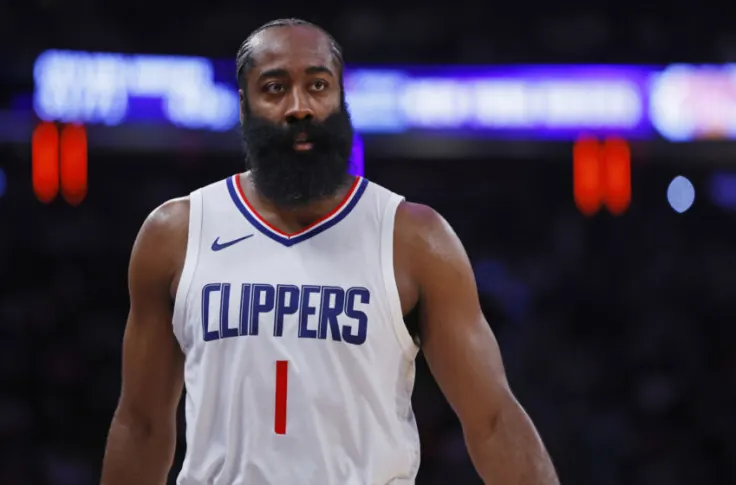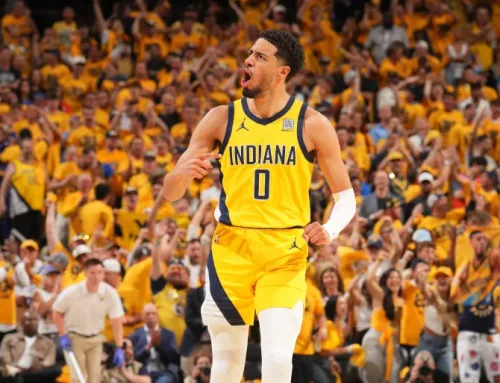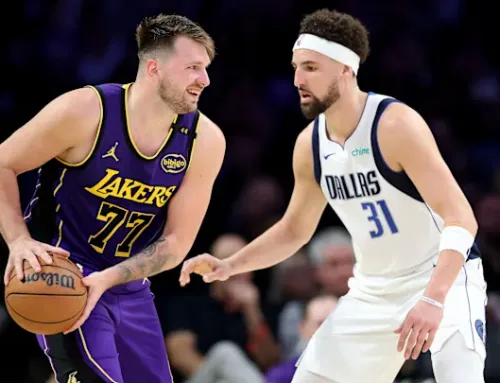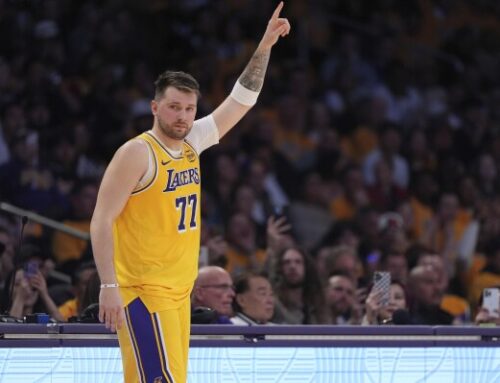Written by Colin Maher, Salary Cap Specialist for No Trade Clause
Introduction
Unless more fireworks occur at the trade deadline (which is always a possibility), the James Harden trade may have been the last time that a Team with a massive team payroll is able to package up all of its mid-range salaries and ship them out for a star player and his bloated salary.
This article breaks down the Traded Player Exceptions (TPE’s) used by the Philadelphia 76ers and Los Angeles Clippers to make the deal happen and the math behind the trade. I also explain how this trade would not happen after the 2023 Salary Cap year as the new CBA phases in more restrictive trade rules.
An Unofficial Glossary
“TPE’s” – The type of exceptions used to make trades over the Salary Cap and applicable Aprons.
“Trade Exception” – In a non-simultaneous trade, it’s the amount the Team can use to trade for another player within one year of receipt (subject to additional limitations not discussed in this article).
Note – The Oklahoma City Thunder were also part of the trade, but only exchanged draft picks and received cash. Draft picks and cash do not count as outgoing/incoming salary in trade, nor do they affect Team Payroll. As this article is discussing the ins and outs of TPE’s in relation to traded player salary, the draft picks and the Thunder’s role in this trade are not discussed in-depth.
Trade Summary
For details regarding pick details and protections, visit NoTradeClause.com/draft-capital
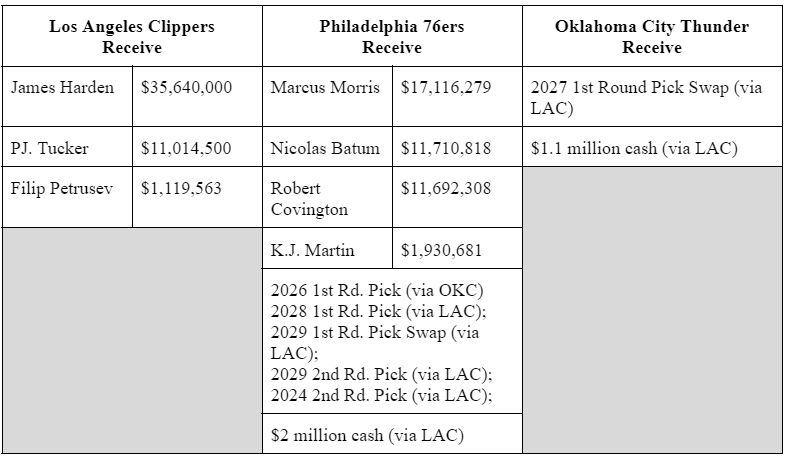
Step 1 – Determining Team Salary
Depending on where a Team’s Team Salary lands in relation to the Salary Cap and Apron thresholds (after the trade is executed), different TPE’s will be available.
The Clippers outgoing player salaries total $42,450,086, while their incoming salaries total $47,814,657.80, and vice versa for the 76ers (except Harden’s $40k Trade Bonus, discussed below, is not considered outgoing team salary for the 76ers), creating a delta of $5,364,4571.60.
As the Clippers were already a “Second Apron Team” before the trade, the increase of $5,323,977 continues to subject them to the limitations of the Second Apron.
The 76ers were roughly $2.3 million over the First Apron before the trade. Therefore, the trade brings them below the First Apron, allowing them as a “Cap Team” to use all Salary Cap exceptions below the Apron Limitations.
Step 2 – Trade Math
A Player’s salary may be calculated differently as incoming/outgoing salary in a trade depending on the contract/transaction type and when the trade is made. Therefore, as is the case in the Harden trade, the “Trade Math” is often different from the Team Salary calculations. In the Harden trade, there were two contracts counted differently. See below:
Petrusev
- Team Salary: $1,119,563,
- Outgoing Salary: ~$559,782, guaranteed salary pro-rated during Regular Season (a rule that adjusts depending upon the date the trade is made)
- Incoming Salary: $0, can be acquired via Minimum Player Salary exception (i.e. no need to use a TPE)
Harden
- Team Salary: $35,680,594.60 ($35,640,000 +$40,594.60 partial Trade Bonus)*
- Outgoing Salary: $35,640,000
- Incoming Salary: $35,680,594.60
*Note on Harden’s salary: Harden had a $5.1 million Trade Bonus, but he had to waive the the majority of the Trade Bonus to allow the trade to work as you will see in Step 3 below.
Step 3 – Exceptions Available
Exceptions Generally
Below are are two essential rules regarding exceptions:
- As stated above, determining a Team’s Team Salary allows us to know which types of TPE’s a Team has access to. You then have to determine if the player’s salary, using the Trade Math, will fit within the TPE type you are trying to use.
- Each team is viewed separately, can use different TPE’s and can even aggregate the trade differently to optimize their TPE, which you will see in this case.
Clippers
As a Second Apron Team, the Clippers have two options: the Standard TPE and the Transition TPE. The Standard TPE only allows one outgoing player to be traded for one or more incoming players at 100% of the player’s outgoing salary. Because they need some aggregation of players to add up to the total salary of Harden’s $35.64 million, this exception is impossible. Therefore they must use the Transition TPE, which allows them to acquire one or more incoming players at 110% incoming salary of one or more outgoing players’ outgoing salary (note both these TPE’s have a $250k cushion that is lost once Team Salary lands over the First Apron).
Below is the math for the Clippers:
A. The Transition TPE barely allows the trade with just over $40,000 to spare before bringing in Harden’s partial Trade Bonus
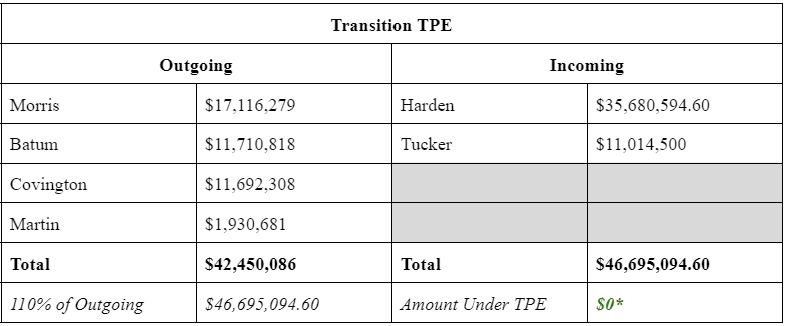
*While it appears they just fit with $0 left remaining under the TPE, Harden could have waived another $45,494.60 of his Trade Bonus (see Step 2 above) to remain under the TPE if needed.
B. The Clippers acquire Petrusev ($0) in exchange for one of the non-player assets (cash or picks).
76ers
When sending more outgoing salary than incoming salary, the goal is always to maximize the largest Trade Exception you can with the available TPE’s available to you. As a Cap Team, the 76ers can use the Standard TPE, Transition TPE or the Expanded TPE.
Remember, the Teams can aggregate the trade how it fits for them and it does not have to align with their counterpart. Here were the 76ers options.
Option 1 – Maximize Trade Exception using Expanded TPE and Standard TPE, but get “Hard Capped”
The 76ers could have used the Expanded TPE, allowing them to acquire one or more incoming players at 125% incoming salary of one or more outgoing players’ salary (as outgoing salary exceeds $29 million) .
They would then use the Standard TPE to create the largest Trade Exception possible for this trade.
Below is the math:
A. Harden sent in his own trade for Morris, Batum and Covington
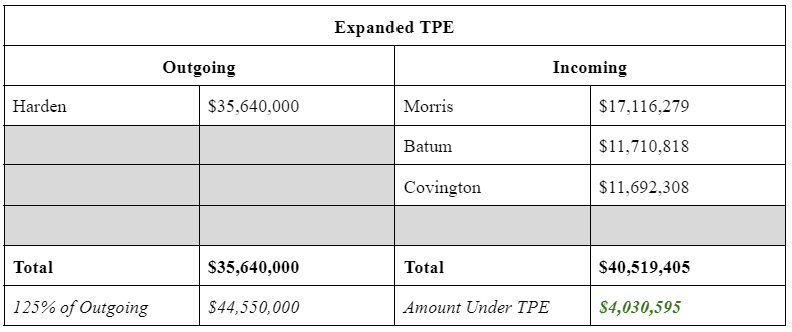
B. Tucker ($11,014,500) sent in his own trade for a non-player asset (either one of the draft picks or the cash-in-trade) via the Standard TPE, generating a $11,014,500 Trade Exception.
C. Petrusev ($559,782) sent in his own trade for a non-player asset (either one of the draft picks or the cash-in-trade) via the Standard TPE, generating a $559,782 Trade Exception.
D. Martin ($0) acquired separately via an existing $2.5 million Trade Exception held by the 76ers.
While this is the way to receive the largest ($11,015,500) Trade Exception in this trade, the 76ers would be forced to “hard cap” themselves. For the rest of the 2023 Salary Cap Year (until 6/30/23), the 76ers could not exceed the First Apron (i.e. they could not increase their Team Salary another ~$2.7 million).
Gaining the $11 million Trade Exception was not worth this limitation to the 76ers. Therefore, they went to Option 2.
Option 2 – Use the Transition TPE and Standard TPE, gain a smaller Trade Exception, and not get Hard Capped
Below is the math:
A. Harden sent in his own trade for Morris and Covington, generating a $6,831,413 Trade Exception.
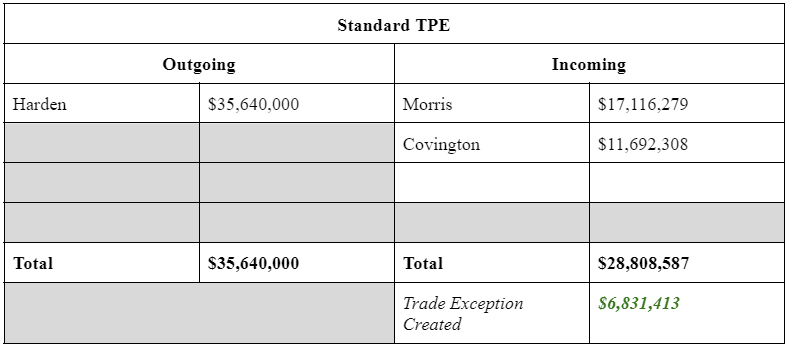
B. Tucker sent in his own trade for Batum using the Transition TPE.

- Petrusev ($559,782) sent in his own trade for a non-player asset (cash or picks) via the Standard TPE, generating a $559,782 Trade Exception.
- Martin ($0) acquired separately via an existing $2.5 million Trade Exception held by the 76ers.
Future Trades Under the New CBA
Needless to say as the new CBA is phased in, tools used to execute the above trade would not have been possible.
Transition TPE
The Transition TPE is labeled just that because it is a way for the League to “transition” to more stringent trade rules for teams over the First and Second Aprons.
First, it is only available during the 2023 Salary Cap year (i.e. until June 30, 2023). The Transition TPE is replaced with the Aggregated TPE, which lowers the permissible amount from 110% to 100%.
Second, remember how the 76ers the Transition TPE so they would not get hard capped? Well after the Regular Season (and before it disappears on July 1, 2024), if a Team uses the Transition TPE then they could potentially be hard capped for the following salary cap year.
To summarize, in 2024, the Clippers would not have been able to execute the trade because Second Apron teams can no longer aggregate players’ salaries in a trade. The 76ers would be able to execute the trade, but would be limited to the Expanded TPE (the Aggregated TPE would not allow Tucker to be traded for Batum at the 100% salary limitation) and would have been hard capped.
Cash-in-Trade
The Clippers, as a Second Apron Team, would also have been prohibited from sending cash as an asset in a trade beginning in the 2024 Salary Cap Year.
Additional Trade Notes
- A player acquired using a Salary Cap Exception (such as a TPE) cannot be aggregated in a future trade for two months (unless acquired before 12/17 and traded the day before the Trade Deadline or later). Thus, the 76ers can trade those acquired in the Harden trade beginning on 1/1/24 (prior to the trade deadline).
- Danny Green was waived by the 76ers to create the extra roster spot to absorb the extra player in the trade. Waiving Danny Green created $200k in dead money for the 76ers.
- Petrusev was reportedly subsequently traded from the Clippers to the Kings.
